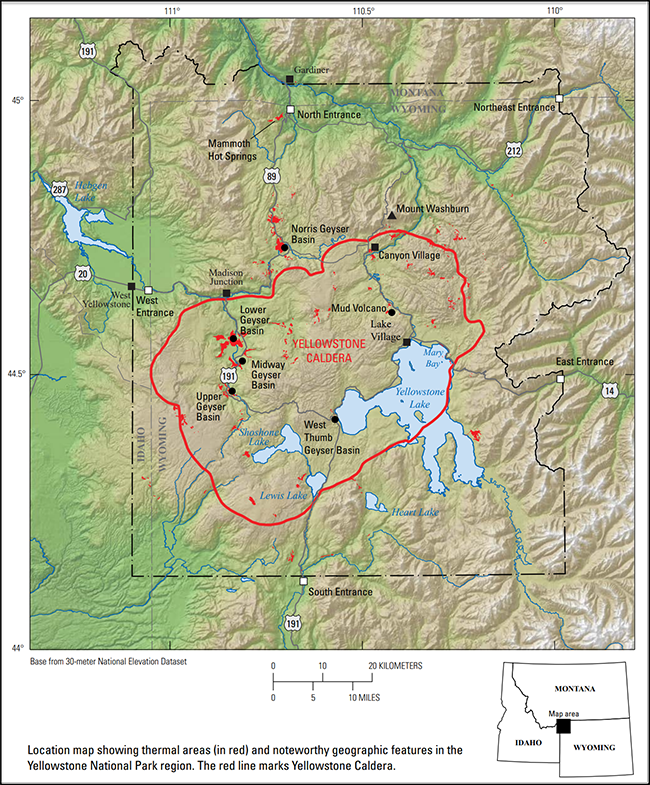
Map outlining Yellowstone Caldera and thermal areas, Yellowstone National Park / YVO 2021 Annual Report
National parks and park units are fantastic science venues. Plenty goes on that we might not notice but which contributes to our understanding of past and present environments and landscapes. At Yellowstone National Park, for example, we might not feel all the earthquakes occurring beneath our feet, or notice alterations to the color of hot springs, or detect uplift or subsidence of the ground on which we stand. We might not notice plenty of things the Yellowstone Volcano Observatory (YVO) notices through field work and equipment specifically designed to collect water chemistry data, identify hydrothermal (heated subsurface water) activity, record seismicity, and so much more.
You may have read about the YVO from the Traveler’s publications of YVO’s Caldera Chronicles. But really, who or what is the YVO?
According to their 2021 annual report, “YVO is a collaborative consortium made up of the U.S. Geological Survey (USGS), Yellowstone National Park, University of Utah, University of Wyoming, Montana State University, UNAVCO, Wyoming State Geological Survey, Montana Bureau of Mines and Geology, and Idaho Geological Survey … [which] monitors volcanic and hydrothermal activity associated with the Yellowstone magmatic system, carries out research into magmatic processes occurring beneath Yellowstone Caldera, and issues timely warnings and guidance related to potential future geologic hazards.”
The YVO publishes annual accounts summarizing scientific research performed within the park. This article you are reading is a synopsis of the 2021 annual report, and you can download and read in PDF format the YVO 2021 Annual Report for a more detailed version of YVO’s research.
During 2021, the YVO
- Placed seismometers in Norris Geyser Basin near Steamboat Geyser and in Upper Geyser Basin in the Geyser Hill area find out more about their plumbing systems,
- Positioned a semipermanent Global Positioning System (GPS) from May to October to “complement the permanent GPS network and to take advantage of generally benign summertime conditions to collect data while avoiding harsh Rocky Mountain winters,”
- Continued their studies of post-glacial hydrothermal activity, refined the ages of Yellowstone volcanic units and updated existing maps of geologic deposits,
- Installed a new continuous gas monitoring station near Mud Volcano (first of its kind in the park),
- Sampled thermal waters around Yellowstone National Park to monitor water chemistry, and
- Assessed heat output using satellite imagery and variations in chloride percentages found in rivers.
Added to findings from previous years’ data, discoveries from 2021 research resulted in numerous observations/conclusions:
Steamboat Geyser
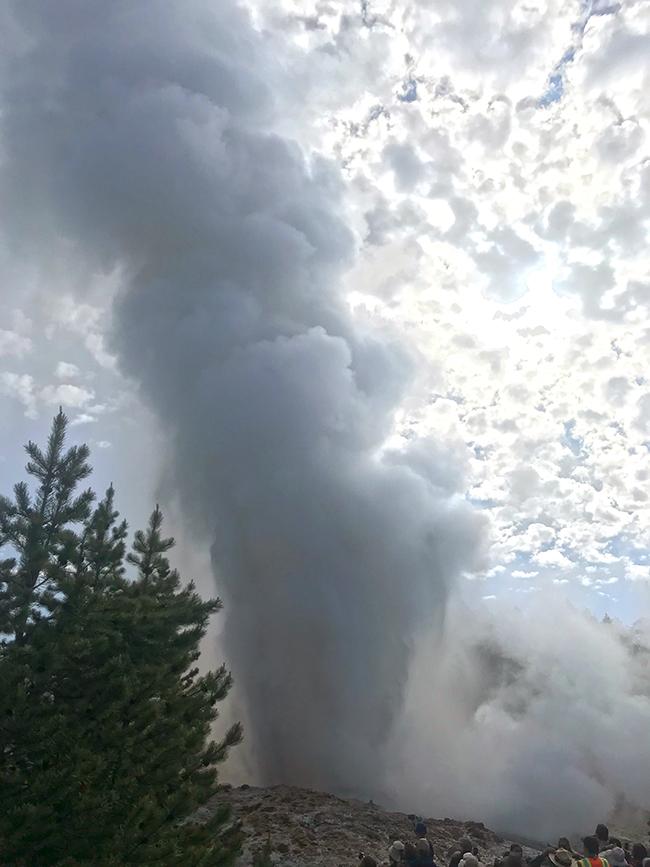
The water phase of a Steamboat Geyser eruption at Norris Basin, Yellowstone National Park / Jamie Farrell
Seismic studies verify the hypothesis of a “deep plumbing system” for Steamboat Geyser (Norris Basin), correlating the height of this geyser’s eruptions (300 – 400 feet high) with inferred depth to the reservoir supplying water to these eruptions. In other words, the water powering this geyser’s eruptions is stored much deeper beneath the Earth’s surface (460 feet/140 meters) than other geysers, like Old Faithful, for instance, which has a plumbing system 260 feet/80 meters deep. The deeper the water is stored, the more power there is to heat and push that water up, up, and away.
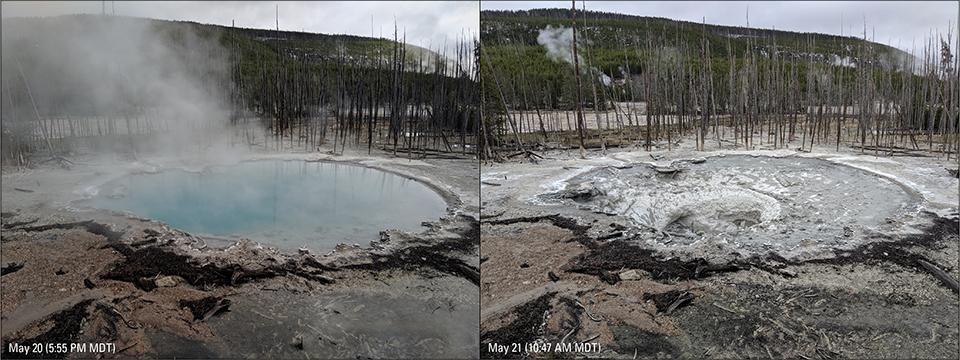
Cistern Spring before and after a Steamboat Geyser eruption, Yellowstone National Park / USGS - Michael Poland
Cistern Spring, located about 300 feet/100 meters downslope of Steamboat Geyser has been an indicator of Steamboat’s upsurges, draining “within a day after each eruption” and then slowly refilling. While the YVO could find no obvious connection between Steamboat Geyser and Cistern Spring, it’s theorized “that the two systems are connected through a network of cracks instead of open pipes.”
Earthquakes
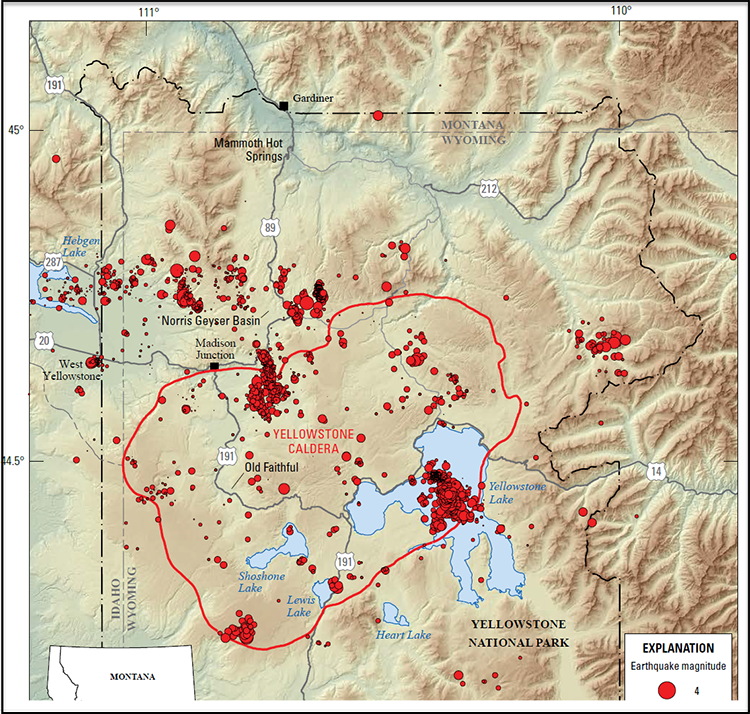
Map of 2021 earthquakes in Yellowstone National Park / YVO 2021 Annual Report
Yellowstone is considered “one of the most seismically active areas in the United States.” The YVO has placed seismic stations all over the park, transmitting real-time data to the University of Utah using radio and satellite telemetry. Note: Telemetry is “the recording and transmission of data from remote or inaccessible sources to an IT system in a different location for monitoring and analysis.”
For 2021, seismic instruments recorded 2,773 earthquakes – the most since 2017 but not anything out of the ordinary compared to other annual quake events in the region. “The total includes 10 magnitude 3 earthquakes, 163 magnitude 2 earthquakes, and 2,600 earthquakes with magnitudes less than 2. Four earthquakes during the year were felt, meaning that people reported some shaking. The largest event of the year was a magnitude 3.6 earthquake, which occurred beneath Yellowstone Lake on July 16 at 6:45 p.m. local time.”
Surface Deformation (Uplift And Subsidence)
That Yellowstone is constantly uplifting is one of the top 10 misconceptions people have about this park. For 2021, geodetic monitoring (the science of measuring the Earth’s shape) utilizing GPS measurements and satellite imagery indicated subsidence within Yellowstone Caldera at a rate of about one inch per year. Despite short bouts of uplift, in general, there’s been subsidence since 2015. A single anomaly noted for 2021 was the uplift along the north rim of the caldera. As YVO Scientist-in-Charge Dr. Michael Poland puts it, think of Yellowstone landscape as “breathing in and out.” For 2021, there was more exhaling than inhaling.
Geochemical Monitoring
YVO scientists monitored gasses from Mud Volcano and the Obsidian Pool area to measure amounts of water vapor, carbon dioxide, hydrogen sulfide, and sulfur dioxide and to document variations in gas composition. They also collected water samples from Upper Geyser Basin, Hillside Springs, Calcite Springs, Potts Hot Spring Basin, Crater Hills, Vermilion Springs, Fountain Paint Pot, and Norris Geyser Basin to better understand “the geological, geochemical, and biological processes that influence water chemistry,” as well as observation of seasonal effects such as snowmelt or drought conditions on thermal waters.
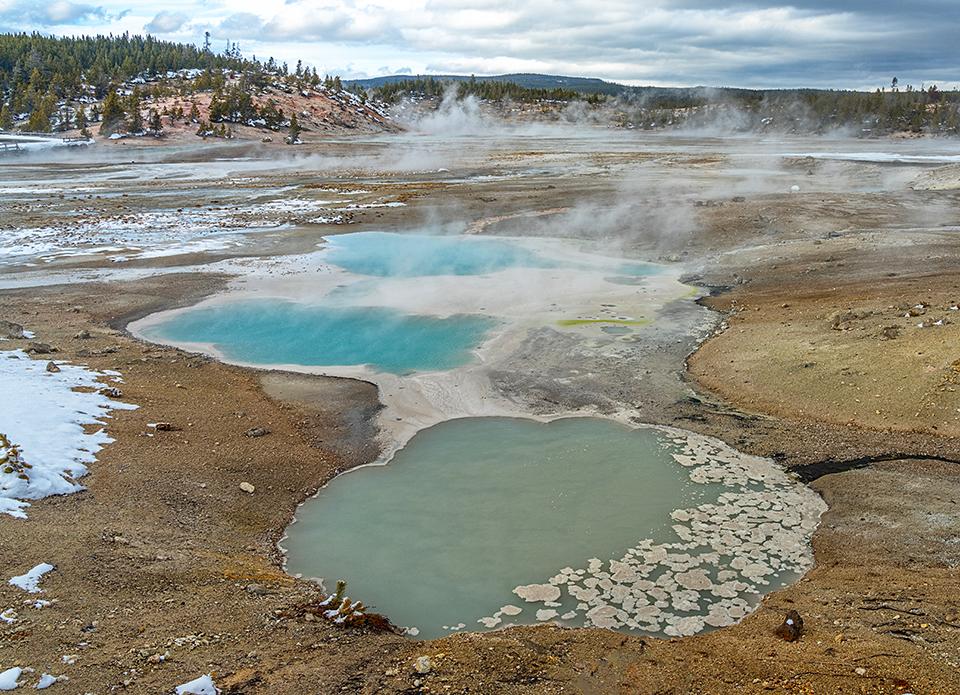
A February 2022 view of Colloidal Pool in Porcelain Basin, Yellowstone National Park / Rebecca Latson
Included in this year’s sampling was Colloidal Pool in Porcelain Basin, a part of the larger Norris Geyser Basin. In the past, Colloidal Pool displayed beautiful opalescent teal-blue water, but in 2021 the appearance was opaque blue-brown water with a foamy surface. The 2021 sample “had lower temperature and conductivity (a measure of how well water carries an electrical current) compared to previous samples collected in 1998 and 2018. To the YVO, this indicates a decrease in the flux [flow] of thermal water flowing into the pool. It’s not uncommon for water chemistry within a thermal feature to change and Colloidal Pool’s water color may be a result of variations in the water table, mixing of subsurface water with water derived from snow or rain (aka meteoric water), the amount / temperature of subsurface boiling, or alterations to the subsurface “pipes” through which that water flows.
Geology
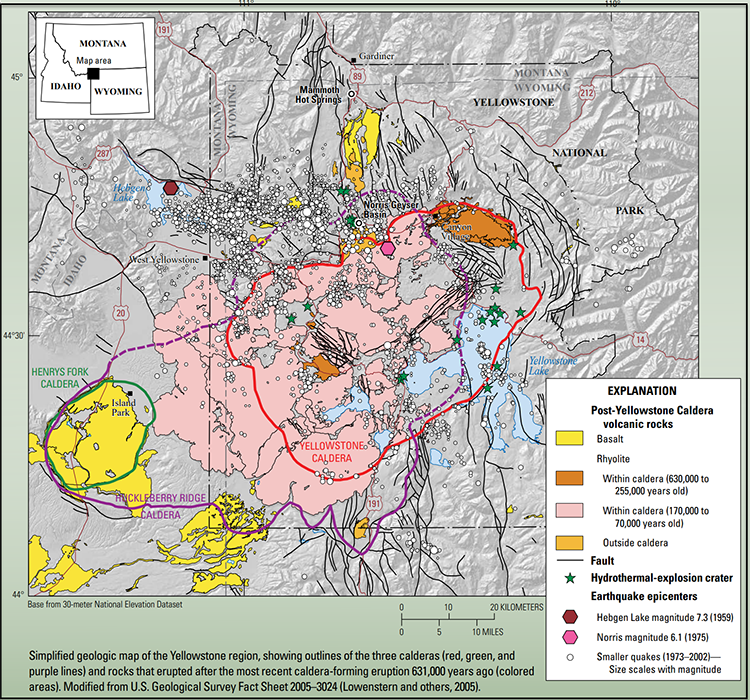
A simplified geologic map of the Yellowstone region, Yellowstone National Park / YVO 2021 Annual Report
Although the COVID-19 pandemic slowed fieldwork, progress continued on “several independent yet related laboratory- and field-based geologic studies,” including dating volcanic (rhyolite and basalt) rocks within Yellowstone National Park to refine the timing of volcanic eruptions occurring after the eruption which created the Yellowstone Caldera.
There were also boundary discrepancies on geologic maps of the area due to “published and unpublished maps completed at different times and scales by different geologists for different purposes,” which the 2021 field work helped correct and refine.
In addition to Mammoth Hot Spring, geologists sampled other travertine deposits to understand their origin and determine their age. Travertine is a form of calcium carbonate. “Hot water interacts with old, marine limestone and magmatic gases at depth. As the water rises and emerges at the surface, the decrease in pressure causes carbon dioxide to degas from the water and calcium carbonate to precipitate.”
Yellowstone Lake Core Studies

Trumpeter swans taking off from Yellowstone Lake, Yellowstone National Park / NPS - Jim Peaco
Yellowstone Lake is the largest high-altitude (above 2,100 meters, or about 6,900 feet) freshwater lake in North America. It covers about 341 square kilometers (132 square miles) of the park and hosts a variety of hot springs and hydrothermal areas beneath its surface.
YVO scientists seeking to understand “how Yellowstone Lake hydrothermal systems respond to geological and environmental changes” over time analyzed lake cores collected during 2021 and previous years to detect “past hydrothermal explosions, faulting, and hydrothermal doming” as well as build “a comprehensive picture of paleoenvironmental conditions from the past 10,000 years...”
Heat Flow Studies
With the aid of satellite thermal infrared data, YVO scientists measured geothermal radiative power (heat output) from the park’s thermal areas (in megawatts). They concluded that radiative power production for 2021 was similar to that measured during previous years. The thermal area with the most heat output was Lower Geyser Basin, “emitting a whopping 713 megawatts. Other large areas with notably high geothermal radiative power output include Norris, Upper, and Midway Geyser Basins, Hot Spring Basin, Astringent Creek, and Roaring Mountain, with values ranging from 100 to 200 megawatts.” A megawatt is a unit used for measuring power output. One megawatt (MW) = 1,000 kilowatts = 1,000,000 watts.
Tracking Thermal Features / Locating Previously Unmapped Thermal Areas
Changes in magma chambers or water conduits to the surface mean changes to Yellowstone’s thermal features. This can lead to dry thermal features filling with water, water-filled thermal features drying up, and even the appearance of new thermal features. YVO scientists continue to track and monitor these alterations as well as map previously unmapped thermal areas within the park’s remote backcountry.
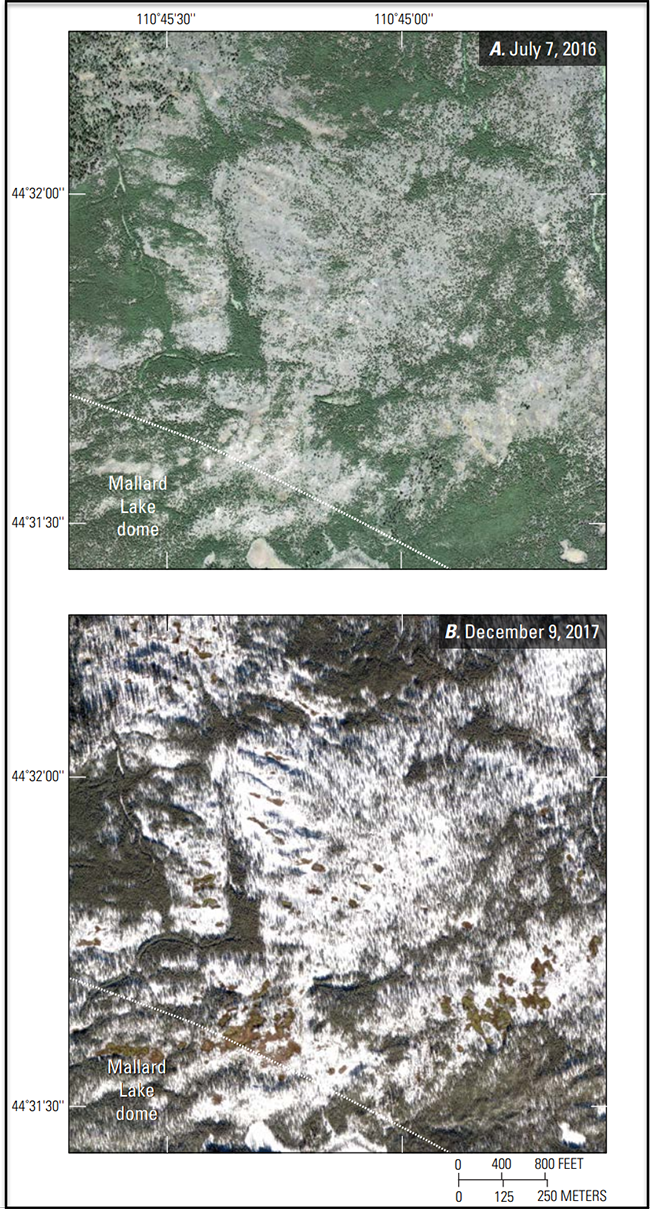
Satellite imagery of previously unidentified thermal areas at Mallard Dome, Yellowstone National Park/YVO 2021 Annual Report
An example of an unmapped thermal area can be found along the north side of the Mallard Lake resurgent dome. According to the USGS, “you can see the profile of the Mallard Lake dome by looking west from DeLacy Creek trailhead along the Grand Loop Road, about midway between West Thumb and Old Faithful.” The landscape there is “barren and fire-scarred” and the numerous small, scattered, isolated thermal areas are often difficult to detect even with thermal-infrared data, due to the low resolution of resulting images. Winter, however, is a great time to distinguish thermal areas because they are warm enough to prevent snow accumulation on and around them. “High-resolution visible imagery acquired in the winter [of 2021], when snow is on the ground, shows the thermal areas more clearly. In fact, these high-resolution visible satellite images are the primary means by which these areas on the north side of Mallard Lake dome were identified.”
Chloride Flux (Variation) Monitoring
Measuring heat output in Yellowstone National Park is not straightforward. There are “thousands of thermal features spread across more than 9,000 square kilometers (3,500 square miles).” One way YVO scientists have captured heat output is to monitor river chemistry and measure chloride concentrations. Water runoff from fumaroles, geysers, and hot springs eventually empty into Yellowstone’s river systems. Ninety-five percent of chloride found in the park’s rivers comes from Yellowstone’s thermal features, so “by monitoring the chloride flux, the hydrothermal discharge and heat flux from the Yellowstone region can be estimated, and variations (both short and long term) can be used to identify changes in the deep hydrothermal system, earthquake activity, geyser eruptions, and other natural events (like floods and the effects of wildfire).”
The Madison, Yellowstone, Snake and Fall Rivers were measured and results indicate the chloride variations are lower than most historical (since 1983) fluxes. No definite conclusions were made in the 2021 report as to the reason for this and the YVO intends to continue monitoring chloride levels to see if this decrease continues.
Hydrothermal Feature Survey
In addition to all the above accomplishments, findings, and conclusions for 2021, the YVO continues its endeavors at locating and documenting every single hydrothermal feature within the park, building upon a previous survey begun in 1998 and completed in 2007. To date, more than 1,100 thermal features have been documented in Norris Geyser Basin, and more than 2,000 in Upper Geyser Basin. Does this count increase from previous surveys indicate new thermal features? Not necessarily. This simply means there might be a “change in inventory protocol—specifically, the types of features that were included in the inventory. Smaller features not included or grouped with other features during the first survey have been classified as separate features in the second survey.”
With each annual report, YVO learns more about the processes shaping Yellowstone National Park. This information is ultimately passed on to the public so they too, can learn about the science of Yellowstone.
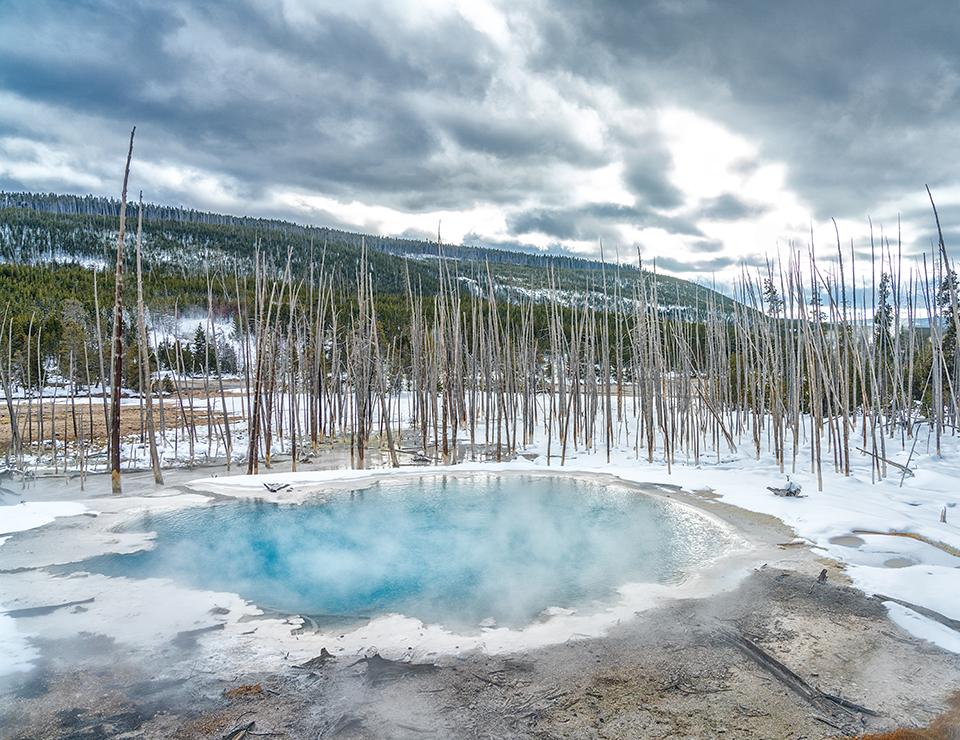
Cistern Spring on a chilly winter morning at Norris Basin, Yellowstone National Park / Rebecca Latson
References
All information and quotes in this article, unless otherwise noted, are taken from the YVO 2021 Annual Report. The links below helped clarify some terms within the report.



Add comment